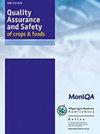茴香精油、NaCl、胆盐及其组合对益生菌酸奶中嗜酸乳杆菌活力的影响
IF 5.3
3区 农林科学
Q1 FOOD SCIENCE & TECHNOLOGY
引用次数: 8
摘要
近年来,对益生菌酸奶精油的研究越来越多。巴旦木是伊朗干旱地区重要的药用野生植物。本研究将嗜酸乳杆菌分别以50最小抑菌浓度(MIC)对桃叶杆菌精油(BEO)、NaCl、胆盐及其组合进行胁迫,然后接种于酸奶样品中,并在4℃下保存28 d。本文中的独立参数为BEO 500和1000ppm,在此时间内评估了酸奶样品中的物理化学,感官特性和嗜酸乳杆菌的活力。观察到,在所有样品中,协同作用百分比、年龄和酸度稳步增加,而pH值降低。在不同处理下,嗜酸乳杆菌的存活率均有所下降。此外,感官得分在样本中呈现下降趋势。氧化还原电位对益生菌的存活率也有影响。酸奶中益生菌数量减少的原因是由于细菌代谢活性导致氧化和复苏电位的增加以及过氧化氢浓度的增加。与其他胁迫处理相比,BEO胁迫下嗜酸乳杆菌的活力最高可能是由于这段时间pH值的变化比胁迫处理要小。一般来说,可以认为在冰箱储存21天的酸奶中添加MIC为50%的BEO、NaCl和胆盐为嗜酸乳杆菌的储存和传播提供了合适的环境,这是消费者推荐的。因此,目前的结果证实,添加益生菌和这些材料改善了酸奶的理化和感官特性。本文章由计算机程序翻译,如有差异,请以英文原文为准。
Effect of Bunium persicum essential oil, NaCl, Bile Salts, and their combinations on the viability of Lactobacillus acidophilus in probiotic yogurt
The probiotic yogurt, with additional essential oil researches, has increased recently. Bunium persicum Boiss is a critical medicinal wild growing plant in Iran dry areas. In this study, Lactobacillus acidophilus was exposed to stress with B. persicum essential oil (BEO), NaCl, bile salts, and their combinations by 50 minimum inhibitory concentration (MIC) and then inoculated to the yogurt samples, which were stored at 4°C for 28 days. Indepen-dent parameters in this article are BEO 500 and 1000 ppm that the physicochemical, sensory properties, and L. acidophilus of viability in yogurt samples were assessed within the time. A steady increase in syneresis percent-age and acidity was observed, while pH values were reduced in all samples. The L. acidophilus survival decreased during storage time in all treatments. In addition, sensory scores showed a reduction trend in the samples. The survival rate of probiotic bacteria is also impacted by redox potential. Increasing the oxidation and resuscitation potential and increasing the hydrogen peroxide concentration due to the bacteria metabolic activity are among the factors that reduce the probiotic bacteria population in yogurt during storage. The most viability of L. acidophilus under stress with BEO compared with other stress treatments may be due to slight changes in pH during this period than in the stress treatments. Generally, it can be argued that the usage of BEO, NaCl, and bile salts at a MIC of 50% in yogurt stored in the refrigerator for 21 days provided a suitable environment for the storage and transmission of L. acidophilus, as recommended to the consumer and, therefore, the current results confirmed that the addition of probiotic and these materials improved the physicochemical and sensory characteristics of yogurt.
求助全文
通过发布文献求助,成功后即可免费获取论文全文。
去求助
来源期刊

Quality Assurance and Safety of Crops & Foods
FOOD SCIENCE & TECHNOLOGY-
CiteScore
4.60
自引率
7.50%
发文量
61
审稿时长
1 months
期刊介绍:
''Quality Assurance and Safety of Crops & Foods'' is an international peer-reviewed journal publishing research and review papers associated with the quality and safety of food and food sources including cereals, grains, oilseeds, fruits, root crops and animal sources. It targets both primary materials and their conversion to human foods. There is a strong focus on the development and application of new analytical tools and their potential for quality assessment, assurance, control and safety. The scope includes issues of risk assessment, traceability, authenticity, food security and socio-economic impacts. Manuscripts presenting novel data and information that are likely to significantly contribute to scientific knowledge in areas of food quality and safety will be considered.
''Quality Assurance and Safety of Crops & Foods'' provides a forum for all those working in the specialist field of food quality and safety to report on the progress and outcomes of their research.
 求助内容:
求助内容: 应助结果提醒方式:
应助结果提醒方式:


